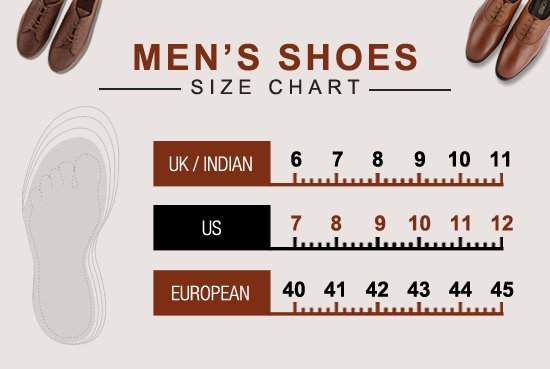Shoe UK Size to India! A Comprehensive Guide
In the UK, shoe sizes are typically measured in inches or a numerical scale, while in India, shoe sizes are often based on the length of the foot in centimeters or millimeters.
For a rough estimation, you can use the following conversion as a guideline:
UK Shoe Size to Approximate Indian Shoe Size:
UK 3 = Indian 36
UK 4 = Indian 37
UK 5 = Indian 38
UK 6 = Indian 39
UK 7 = Indian 40
UK 8 = Indian 41
UK 9 = Indian 42
UK 10 = Indian 43
How to Understand UK Shoe Sizes?

The UK shoe size system is primarily based on the length of the foot measured in inches. It follows a numerical scale, typically ranging from 1 to 13 for men’s sizes and 2 to 9 for women’s sizes, although there are variations beyond these ranges for specialty sizes. Each size increment represents a difference of 1/3 inch in foot length. Children’s shoe sizes in the UK also follow a specific scale.
Notably, the UK shoe size system doesn’t solely rely on foot length; width measurements, often denoted by letters such as ‘E’ for narrow or ‘G’ for wider fittings, are incorporated to ensure a better fit for various foot shapes.
Measurement standards used in the UK sizing:
In the UK, shoe sizes are traditionally determined by measuring the length of the foot in inches. This measurement is usually taken from the heel to the longest toe (commonly the big toe), while the width may also be considered for a more precise fitting.
Additionally, the UK shoe sizing standards account for variations in foot width, denoted by alphabetical indicators. These width indicators are used in conjunction with the numerical shoe size to offer different fittings and accommodate the diversity of foot shapes.
Examples of UK shoe sizes
UK shoe sizes can vary for men, women, and children, ranging from different numerical scales for each category. For instance:
Men’s shoe sizes typically range from UK 6 to UK 12, with increments of 1/3 inch per size.
Women’s sizes commonly range from UK 3 to UK 8, also following the 1/3 inch difference between sizes.
Children’s shoe sizes in the UK adhere to a different scale, often starting from Infant sizes (e.g., UK 1 to UK 13) before transitioning to Junior sizes (e.g., UK 1 to UK 6).
Moreover, UK shoe sizes may have variations in fitting options (such as wide or narrow), denoted by additional letters accompanying the numerical size.
What Defines Indian Shoe Sizes?
The Indian shoe size system primarily uses the length of the foot measured in centimeters or millimeters. Unlike some other sizing systems that may have separate scales for men, women, and children, the Indian shoe size system typically follows a unified scale for all genders and age groups.
Indian shoe sizes are commonly based on the length of the foot in centimeters, which correlates to a specific shoe size. For example, a foot measuring 24 centimeters may correspond to a certain Indian shoe size.
Measurement standards used in Indian sizing
In Indian shoe sizing, the length of the foot is the central measurement standard. The foot length is measured from the heel to the longest toe, usually the big toe, and this measurement is expressed in centimeters or millimeters.
The Indian sizing standards prioritize the measurement of the foot’s length to determine the appropriate shoe size, without considering additional factors such as width variations in the standard sizing system.
Examples of Indian shoe sizes
Indian shoe sizes are directly associated with the measured length of the foot in centimeters. For instance:
A foot length of approximately 22 cm might correspond to a specific Indian shoe size.
Another foot measuring around 26 cm would align with a different Indian shoe size.
Unlike some other countries where separate size scales exist for men, women, and children, the Indian shoe size system generally follows a unified sizing scale based on foot length for all genders and age groups.
What Challenges Arise Converting UK to Indian Shoe Sizes?
Converting UK shoe sizes to Indian sizes faces challenges due to differences in measurement units, the absence of standardized conversion charts, and variations in sizing among different shoe brands.
Differences in measurement units (inches vs. centimeters)
The primary challenge arises from the difference in measurement units used in the UK and Indian shoe size systems. The UK shoe sizes are typically based on inches, representing the length of the foot, while Indian sizes are based on centimeters or millimeters. This difference in measurement units makes direct conversion complex and imprecise, requiring a conversion factor that may not be universally standardized.
Converting between inches and centimeters involves a conversion rate of 1 inch equal to 2.54 centimeters. However, the fractional differences within shoe sizes based on 1/3 inch increments in the UK system and centimeter-based sizes in India add complexity to precise conversions.
Lack of standardized conversion charts
Another challenge is the absence of universally accepted or standardized conversion charts that provide accurate and consistent conversions between UK and Indian shoe sizes. The lack of an official or widely recognized conversion chart leads to inconsistencies and discrepancies in conversions, causing confusion for consumers when trying to determine their appropriate size across different sizing systems.
While some brands or retailers may offer their conversion charts, these charts may vary, leading to inconsistencies and making it challenging for consumers to rely on a single conversion guide.
Variations in sizing among different shoe brands
Sizing discrepancies among different shoe brands further complicate the conversion process. Brands often have their own unique sizing standards, fitting preferences, and interpretations of size measurements. As a result, a particular UK size from one brand may not perfectly align with the equivalent size in another brand’s Indian sizing, even when following a conversion chart.
Variations in design, shoe shape, manufacturing processes, and intended market demographics contribute to these differences. Therefore, a particular UK-to-Indian size conversion that might work for one brand could prove inaccurate for another due to these brand-specific variations.
FAQ’s
Is size 6 in UK XS?
No, generally, size 6 in the UK is not considered extra small (XS). Sizes can vary across brands and garment types, so it’s essential to check the specific sizing chart for accurate information.
What is the UK size 6 top?
In the UK, a size 6 for tops typically corresponds to a bust measurement of around 30 inches or 76 centimeters, but this can vary between brands.
What letter is a size 6?
In the UK sizing system for clothing, size 6 typically doesn’t have a specific letter associated with it. Letters such as XS, S, M, L, etc., often correspond to different size ranges.
Is XS size 6 or 8?
In the UK sizing system, XS is generally smaller than size 6. XS commonly corresponds to a smaller size, usually around sizes 4 or 6, but sizing can vary between brands.
What is size 6 equivalent to?
Size 6 in the UK can vary in equivalency depending on the type of clothing. For tops, it may equate to a bust measurement around 30 inches. In trousers or bottoms, it could correspond to a waist measurement of approximately 23-24 inches.
What is EU UK size 6?
In the European (EU) sizing system, UK size 6 approximately corresponds to EU size 34. However, it’s essential to refer to brand-specific size charts as conversions may differ between brands and garment types.
Final Words
In conclusion, understanding shoe sizes between the UK and India can be quite tricky due to various differences. The UK shoe size system relies on inches while the Indian system uses centimeters, making direct conversions challenging. Additionally, the absence of standardized conversion charts adds to the confusion, making it hard to find precise equivalents between the two sizing systems. Moreover, variations in sizing among different shoe brands further complicate matters. Therefore, it’s crucial for individuals to refer to brand-specific size charts or consult with retailers for accurate conversions.





